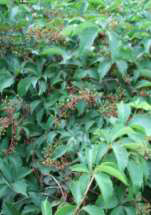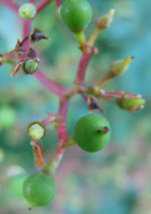 Virginia Creeper
Virginia Creeper
(Parthenocissus quinquefolia (L.) Planch.)
|
Classification |
| Kingdom: |
Plantae |
| Division: |
Magnoliophyta |
| Class: |
Magnoliopsida |
| Order: |
Vitales |
| Family: |
Vitaceae |
| Genus: |
Parthenocissus |
| Species: |
quinquefolia |
Characteristics: Virginia creeper is a perennial plant and a prolific climber, reaching heights of 60 to 100 feet. It climbs smooth surfaces using small forked tendrils tipped with small strongly adhesive pads. The leaves are palmately compound, comprised of five leaflets joined from a central point on the leafstalk, and range from 1 to 8 inches across. The flowers are small and greenish, produced in clusters in the late spring. In the summer or early fall, the fruit form and mature into small hard purplish-black berries. The berries are then eaten and distributed by a wide variety of songbirds.
 Habitat: Virginia Creeper will grow in deciduous woodlands, forest borders, thickets, gravelly seeps, limestone glades, rocky bluffs, fence rows, and walls of buildings. It can adapt to disturbed habitats in both rural and urban areas.
Habitat: Virginia Creeper will grow in deciduous woodlands, forest borders, thickets, gravelly seeps, limestone glades, rocky bluffs, fence rows, and walls of buildings. It can adapt to disturbed habitats in both rural and urban areas.
Range: It can be found throughout the eastern and central regions of North America, as far west as Utah and Texas.
Native American Uses: An infusion made from Virginia Creeper was used to treat jaundice. Also, a compound decoction of twigs was used as a wash to counteract poison sumac. The plant was also used as an herbal remedy for diarrhea, swelling, lockjaw, as well as a urinary aid. The Cherokee and Iroquois are among the Native American tribes known to have utilized this species.
Modern Uses: Virginia creeper is grown as an ornamental plant and can be used as a shading vine for buildings with masonry walls. The berries of this plant contain oxalic acid, which is poisonous to humans and other mammals, and may be fatal if eaten.